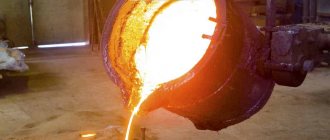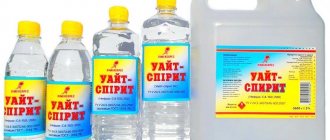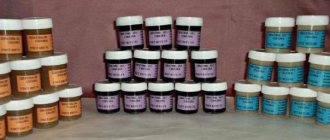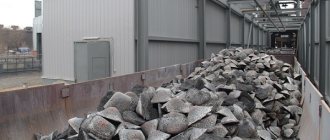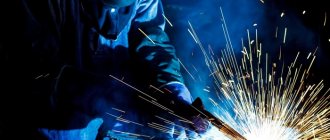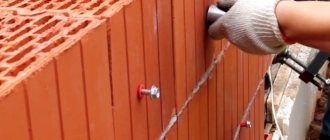What is cast iron
So, let's find out which iron-carbon alloys are called cast irons.
Concept
Cast iron is an iron-carbon alloy containing carbon, that is, it means a material that consists of an alloy of iron and carbon. The percentage of carbon in cast iron is more than 2.14%. The latter element can be included in cast iron in the form of graphite or cementite.
This video talks about the features of cast iron:
Varieties
There are white and gray cast iron.
- The carbon in white cast iron is in the form of iron carbide. If you break it, you can see a white tint. White cast iron is not used in its pure form. It is added to the process of producing malleable iron.
- At a fracture, gray cast iron has a silvery tint. This type of cast iron has a wide range of uses. It lends itself well to processing with cutters.
In addition, cast irons are high-strength, malleable and with special properties.
- High-strength cast iron is used to increase the strength of the product. The mechanical properties of such cast iron allow this to be done perfectly. High-strength cast iron is obtained from gray cast iron by adding magnesium to the mass.
- Ductile iron is a type of gray iron. The name does not mean that this cast iron is easily forged. It has increased plasticity properties. It is obtained by annealing white cast iron.
- There is also a distinction between half cast iron. Some of the carbon in it is in the form of graphite, and the remaining part is in the form of cementite.
Special Features
The peculiarity of cast iron lies in the process of its production. The average melting point of different types of cast iron is 1200ºC. This value is 300 degrees less than that of steel. This is due to the very high carbon content. Carbon and iron atoms do not have a very close connection with each other.
When the smelting process takes place, carbon cannot be completely incorporated into the iron lattice. As a result, cast iron takes on the property of brittleness. It cannot be used for the manufacture of parts that will be subject to constant load.
Cast iron is a ferrous metallurgy material. Its characteristics are often compared to steel. Products made of steel or cast iron are widely used in our lives. Their use is justified. After comparing the characteristics, we can say the following about these two materials:
- The cost of cast iron products is lower than the cost of steel ones.
- Materials vary in color. Cast iron is a dark matte material, while steel is light and shiny.
- Cast iron is easier to cast than steel. But steel is easier to weld and forge.
- Cast iron is less durable than steel.
- Cast iron is lighter in weight than steel.
- Steel has a higher carbon content than steel.
Advantages and disadvantages
Cast iron, like any material, has positive and negative sides.
The advantages of cast iron include:
- Carbon in cast iron can be in different states. Therefore, this material can be of two types (gray and white).
- Certain types of cast iron have increased strength, so cast iron is sometimes placed on the same line as steel.
- Cast iron can maintain temperature for quite a long time. That is, when heated, the heat is evenly distributed throughout the material and remains in it for a long time.
- In terms of environmental friendliness, cast iron is a clean material. Therefore, it is often used to make dishes in which food is subsequently prepared.
- Cast iron is resistant to acid-base conditions.
- Cast iron has good hygiene.
- The material has a fairly long service life. It has been noticed that the longer cast iron is used, the better its quality.
- Cast iron is a durable material.
- Cast iron is a harmless material. It is not capable of causing even slight harm to the body.
The disadvantages of cast iron include:
- Cast iron will rust if it is exposed to water for a short time.
- Cast iron is an expensive material. However, this minus is justified. Cast iron is very high quality, practical and reliable. Items made from it are also high quality and durable.
- Gray cast iron is characterized by low ductility.
- White cast iron is characterized by brittleness. It is mainly used for smelting.
Classification of cast irons
A characteristic feature of cast iron is that carbon in the alloy can be found not only in a dissolved and bound state (in the form of a chemical compound - cementite Fe 3 C), but also in a free state - in the form of graphite. In this case, the shape of the graphite deposits and the structure of the metal base (matrix) determine the main types of cast iron and their properties.
Classification of cast iron with various forms of graphite is carried out according to GOST 3443-77. Specially designed scales are used to evaluate the shape of graphite inclusions, their size, distribution and quantity, and the type of metal base.
Cast iron is classified according to the following criteria:
- according to the state of carbon - free or bound;
- in the form of graphite inclusions - lamellar, worm-shaped, spherical, scaly (Fig. 30);
- according to the type of structure of the metal base (matrix) - ferritic, pearlitic; There are also cast irons with a mixed structure: for example, ferrite-pearlite;
- according to the chemical composition - unalloyed (general purpose) and alloyed (special) cast irons.
Depending on the form of carbon release in cast iron, there are:
- white cast iron, in which all carbon is bound in the form of cementite Fe 3 C;
- semi-fat cast iron, in which the main amount of carbon (more than 0.8%) is in the form of cementite;
- gray cast iron in which all or most of the carbon is free in the form of flake graphite;
- bleached cast iron, in which the bulk of the metal has the structure of gray cast iron, and the surface layer is white;
- malleable cast iron, in which the graphite is spherical;
- malleable cast iron, obtained from white by annealing, in which the carbon passes into a free state in the form of flake graphite.
Properties and characteristics
Cast iron has the following properties:
- Physical . These characteristics include: specific gravity, coefficient of linear expansion, actual shrinkage. Specific gravity varies depending on the carbon content of the material.
- Thermal . The thermal conductivity of a material is usually calculated using the displacement rule. For solid cast iron, the volumetric heat capacity is 1 cal/cm3*oC. If cast iron is liquid, then it is approximately 1.5 cal/cm3*oC.
- Mechanical . These properties depend on the base itself, as well as on the size and shape of the graphite. Gray cast iron with a pearlite base is considered the most durable, and the most ductile is with a ferritic base. The maximum reduction in strength is observed with the “plate” shape of graphite, and the minimum – with the “ball” shape.
- Hydrodynamic . Viscosity in cast iron varies depending on the presence of manganese and sulfur. It also increases sharply when the temperature of cast iron passes the point where solidification begins.
- Technological. Cast iron has excellent casting properties, resistance to wear and vibration.
- Chemical . According to the electrode potential (in decreasing order), the structural components of cast iron are arranged in the following form: cementite - phosphide eutectic - ferrite.
Differences between cast iron and steel in chemical composition and properties
The properties of cast iron are affected by special impurities.
- Thus, the addition of sulfur can significantly reduce fluidity and reduce refractoriness.
- The addition of phosphorus simultaneously makes it possible to create a product of complex shape, but does not give it increased strength.
- The silicon impurity makes the melting point not so high and significantly improves the casting properties. Different percentages of silicon create different types of cast iron, from pure white to ferritic.
- Manganese worsens casting and technological properties, but increases strength and hardness.
In addition to the mentioned impurities, cast iron may also contain other components. Then such materials will be called alloyed. The most common materials added to cast iron are titanium, chromium, aluminum, nickel and copper.
Next, you will find out what elements are included in the chemical composition of cast iron.
The video below will show you how to weld cast iron using electric welding:
Physical properties
Cast iron has become widespread due to its attractive physical properties:
- The cost of the material is significantly lower than the cost of other alloys. That is why it is used to create a wide variety of products.
- Considering the density of cast iron, we note that this indicator is significantly lower than that of steel, due to which the material becomes much lighter.
- The melting point of cast iron can vary slightly depending on its structure, but in most cases it is 1,200 degrees Celsius. Due to the inclusion of various additives in the composition, the melting point of cast iron can significantly increase or decrease.
- When choosing a material, many pay attention to the fact that the color of cast iron may differ slightly depending on the structure and chemical composition.
The boiling point of cast iron also largely depends on the chemical composition. In order to consider the physical properties of a material, attention should be paid to each of its varieties. A different structure and chemical composition cause different physical and mechanical properties to be imparted.
Structure and composition
If we consider cast iron as a structural material, then it is a metal cavity with graphite inclusions. The structure of cast iron is mainly pearlite, ledeburite and ductile graphite. Moreover, for each type of cast iron these elements predominate in different proportions or are absent altogether.
According to the structure of cast iron there are:
- perlite,
- ferritic and
- ferritic-pearlitic.
Graphite is present in this material in one of the forms:
- Globular. Graphite takes on this shape when magnesium is added. The spherical shape of graphite is characteristic of high-strength cast irons.
- Plastic. Graphite is similar to the shape of petals. In this form, graphite is present in ordinary cast iron. This cast iron has increased ductility properties.
- Flaky. Graphite acquires this shape by annealing white cast iron. Graphite is found in flake form in malleable cast iron.
- Vermicular. The named form of graphite is found in gray cast iron. It was developed specifically to improve ductility and other properties.
Gray cast iron
Gray (cast) cast iron
- an alloy of iron and graphite, which is present in the form of plates or fibers.
Gray cast iron is characterized by high casting properties (low crystallization temperature, high fluidity, low shrinkage) and serves as the main material for casting. Widely used in mechanical engineering for casting machine beds and mechanisms, pistons, cylinders.
In addition to carbon, gray cast iron contains other elements. The most important of them are silicon and manganese. In most grades of gray cast iron, the carbon content is in the range of 2.4-3.8%, silicon 1.0-4.0% and manganese up to 1.4%.
Metal production
Cast iron is produced in special blast furnaces. The main raw material for producing cast iron is iron ore. The technological process consists of reducing the iron oxides of the ore and obtaining another material as a result - cast iron. The following fuels are used to make cast iron: coke, natural gas and thermal anthracite.
Once the ore is reduced, the iron is in a solid form. Next, it is lowered into a special part of the furnace (steam), where carbon is dissolved in the iron. The output is liquid cast iron, which falls into the lower part of the furnace.
The price of cast iron (per 1 kg) depends on the amount of carbon in it, the presence of additional impurities and alloying components. Approximately the price of a ton of cast iron will be 8,000 rubles.
The influence of temperature on the mechanical properties of cast iron
The general pattern of the influence of elevated temperatures on the mechanical properties of cast iron is a decrease in strength, hardness and elasticity with a simultaneous increase in ductility and viscosity up to a certain limit, after which these properties begin to decrease. Comparing the mechanical properties of different cast irons during short-term tests, one can see (Fig. 245) that the strength of cast iron is characterized by a minimum at 150-250 ° C, but at 350-450 ° C it differs little from the strength at normal temperature and only after that begins to monotonously and decrease rapidly. However, in high-strength cast iron this anomaly (although noted in Fig. 245) is found less frequently. The reason for the formation of this minimum has not yet been finally determined; it is assumed that this is a consequence of stresses of the second kind, formed due to the difference in the expansion coefficient of cementite and ferrite in pearlite, magnetic transformations of carbides, gas release, dispersion hardening and other factors. In any case, we can assume that the frequent absence of this minimum on high-strength cast iron indicates that gases play an important role in this matter.
The modulus of elasticity drops very intensively and monotonically in all cast irons, which for temperatures up to 700°C can be approximately expressed by the formula where E and Et are the modulus of elasticity at normal and elevated (t) temperatures (°C);
a and b are coefficients, the value of which for high-strength cast iron is 0.0068 * 10v-2 and 0.0044 * 10v-4, respectively.
At the same time, the cyclic viscosity of cast iron does not change at all with increasing temperature, which refutes statements about a strict and unambiguous connection between this property and the elastic modulus and indicates the existence of a more complex relationship.
The nature of the curve of change in the plasticity of cast iron with temperature appears at first (up to 400-500 ° C) to be an almost horizontal, often even slightly falling curve, followed by a sharp rise (Fig. 245), reaching a maximum in the region of 800-1000 ° C, after which it begins an equally sharp drop at higher temperatures. Thus, near the eutectic temperature, all cast irons, like other alloys, are characterized by very low values of strength, elasticity and ductility. The impact strength of cast iron changes in approximately the same way, although the corresponding temperature dependence curve is more complex due to different changes in strength and ductility.
Of particular interest is hot hardness, the ease of determination of which makes it possible to evaluate the corresponding strength of cast iron, since the nature of the influence of temperature in both cases is approximately the same. The intense drop in hardness, which begins at approximately 430° C, can be expressed by the formula
where B is the softening coefficient, which fluctuates for temperatures above the inflection within the range (30/36) * 10v-4 (a lower value corresponds to gray cast iron, a higher value corresponds to malleable and high-strength cast iron).
The influence of the chemical composition of cast iron on its properties at elevated temperatures in most cases is approximately the same as at normal temperatures. Reducing eutecticity increases the short-term and long-term strength of gray cast iron, which is due to the reduction in the amount and grinding of graphite. The compact and spherical forms of graphite in malleable and high-strength cast iron have an even more beneficial effect (Table 32) and in approximately the same ratio as at normal temperature. In this case, alloying elements are as useful or even more useful than at normal temperatures. The most effective of them is molybdenum, which increases not only short-term and long-term strength, as can be seen from Fig. 246, but also the creep resistance of cast iron. The maximum of this effect appears at 1.5-2.0% Mo; as with the action of other elements and factors, it decreases as the temperature rises, so that the long-term strength of cast iron at 650 ° C no longer depends much on alloying. Like molybdenum, chromium and nickel have a beneficial effect, although with less intensity, in particular by adding naturally alloyed Khalilov cast iron, as shown in Table. 33.
The effect of chromium is especially favorable in the high temperature region for the additional reason that it stabilizes the structure.
With a high content of graphitizing elements, in particular silicon, one can be afraid of a decrease in strength due to the decomposition of pearlite. However, copper in amounts of about 0.5% is quite useful in these cases, especially in ductile iron. In this case, we can again note the general pattern: the higher the temperature, the less the influence of the composition of the metal. This can be confirmed, for example, in relation to malleable cast iron in Fig. 247, which shows that the benefits of low carbon content only appear at temperatures up to 425°C. However, alloying with nickel, chromium, copper and molybdenum, as can be seen from table. 33 and other works, for example, in some cases still retains its advantages in the region of elevated temperatures, but mainly during long-term tests; in short-term tests this manifests itself to a small extent. The above is also true for creep, which manifests itself in cast iron starting from 350-400 ° C. In this case, high-strength cast iron, especially pearlitic, has clear advantages over gray cast iron, although alloying can sometimes change this ratio. And indeed, as can be seen from Fig. 248, gray cast iron alloyed with molybdenum and chromium is characterized by greater resistance at low creep rates than unalloyed nodular cast iron. However, this is not always observed, and at high creep rates, high-strength cast iron, even ferritic, has higher properties, which can be further improved by alloying and perlitizing the structure (Fig. 248). The highest properties in this regard are characterized by austenitic nickel cast irons (Fig. 249) with lamellar and especially nodular graphite, despite the fact that at normal temperatures they are inferior in strength to ordinary pearlitic cast irons. Some of these cast irons, as can be seen from Fig. 250, in terms of short-term and long-term strength are very close to austenitic steel 1Х18Н9, although in terms of creep resistance they are significantly inferior to it. The GOST draft for heat-resistant cast iron, developed by TsNIITmash (Table 34), therefore provides only austenitic cast iron with nodular graphite, which must meet certain requirements for mechanical properties at normal and elevated temperatures.
The creep rate of cast irons given in table. 34, at 600° C for a time of 400-1200 hours at a voltage of 4 kg/mm2 is 1.0 * 10v-4, long-term strength at 600° C is odl1400 = 12 kg/mm4, and for the ChN19MSh grade this strength corresponds even to 2800 h. Such high properties of austenitic cast irons at elevated temperatures are undoubtedly favored not only by their chemical composition, but also by the stability of their structure.
Therefore, under these conditions, cast irons with stable ferrite are also effective, although to a lesser extent, for example, silicon cast iron, ZhChS-5.5 or ZhChSSh-5.5, which has superior properties, with nodular graphite.
In general, it should be pointed out that cast iron, due to its high carbon content, even with the most favorable structure and composition, does not have high heat-resistant properties and is applicable only at relatively low temperatures, usually no higher than 350-450 ° C.
In some cases, castings made of white cast iron, most often alloyed with chromium, also work satisfactorily at elevated temperatures. In Fig. 251 is presented for comparison with austenitic and pearlitic cast irons; the hot strength of white high-alloy cast iron of the Chromex type with a content of 28-34% Cr (Kh28L and Kh34L according to GOST 2176-57). Cast irons Kh28L and Kh34L, like pearlitic ones, are characterized by a more intense decrease in strength with increasing temperature than austenitic cast irons. The ductility of these cast irons, very low at normal temperatures, increases starting at 400° C and reaches a maximum (-100%) at temperatures of about 900-1050° C, when the transformation of ferrite into austenite occurs. Impact toughness also increases with increasing temperature and also reaches a maximum in the austenitic state, as can be seen in Fig. 251, a. The mechanical properties of high-chromium cast irons strongly depend on the chemical composition and heat treatment regime. As for composition, the most important elements are carbon and silicon: the first, as can be seen from Fig. 251, b, increases, and the second decreases strength at high temperatures, while both elements have a negative effect on plastic properties.
The mechanical properties of these cast irons are even more influenced by heat treatment, through which it is possible to obtain austenitic (1150°C air), martensitic (1000C -> air) or ferritic (1000°C -> furnace cooling) structures, and therefore corresponding change in mechanical properties. In addition, during the heat treatment of these cast irons, dispersion hardening (at 400-550 ° C) and the formation of the o-phase at 650-800 ° C are also possible, which, of course, affects the mechanical properties (Table 35), and in this case mainly the ductility and viscosity of cast iron decreases.
The general pattern of changes in mechanical properties at low temperatures is a slight increase in strength and hardness and a decrease in ductility and toughness, but these changes significantly depend on the type and structure of cast iron. In ordinary gray (pearlite) cast iron they are relatively small and on average are:
As can be seen from these data, the strength of pearlitic cast iron increases to a small extent with decreasing temperature.
Ferritic cast irons are strengthened to a greater extent and lose their plastic properties less, as can be seen, for example, from testing gray cast iron at -269 ° C:
All properties of gray cast iron, including impact strength, change monotonically with decreasing temperature without any jump. This is apparently explained by the fact that cast iron at these temperatures is already in the region below the brittleness threshold. The advantages of the ferritic structure are also retained in high-strength cast iron, as evidenced by the following data:
While high-strength cast iron with a pearlite structure significantly loses strength at very low temperatures, ferritic cast iron loses only its ductility, but its strength increases significantly.
Austenitic cast irons have even greater advantages. In this case, hardening occurs more intensively, and the impact toughness changes little or even increases up to the transformation temperature and only then drops sharply. So, for example, for austenitic cast iron with lamellar graphite and a transformation temperature of -88° C, the following was found:
The mechanical properties of malleable and high-strength cast iron change in approximately the same way, only their impact strength drops more sharply when passing through the brittleness threshold, while their hardness changes little:
Of particular interest is the search for cast irons with increased strength and sufficient ductility at very low temperatures (-200 ° C or -269 °, i.e. at temperatures of liquid nitrogen and helium). It is obvious that such a cold-ductile cast iron should be a high-nickel alloy with an austenitic structure characterized by a low brittleness threshold. Research has shown that austenitic cast iron (2.44% C; 2.25% Si; 3.92 Mn; 22.0% Ni; 0.25% Cr and 0.12% Mg) has such properties, characterized by the following properties at low temperatures after normalization from 900°C:
It is especially important to note that the impact strength of cast iron remains high: even after exposure at -196 ° C for 2550 hours it was in the range of 4.2-4.8 kg*m/cm2 according to Charly, which indicates that even with at a temperature of -196° C, cast iron did not go into a brittle state. Very high properties of this kind were also shown by austenitic high-nickel cast iron (2% C; 1.8% Si; 0.5% Mn; 0.02% P; 0.02% S; 30% Ni) with lamellar and spherical graphite at a temperature -269° C:
In conclusion, it should be noted that the strength of austenitic cast iron, like ferritic cast iron, increases sharply at very low temperatures, ductility also remains relatively high, so these cast irons are most suitable for working under these conditions.
Areas of use
Cast iron is common in many areas.
- It is used for the production of parts in mechanical engineering. Engine blocks and crankshafts are mainly made from cast iron. The latter require advanced cast iron, to which special graphite additives are added. Due to the resistance of cast iron to friction, it is used to make excellent quality brake pads.
- Cast iron can operate smoothly even at extremely low temperatures. Therefore, it is often used in the production of machine parts that will have to work in harsh climatic conditions.
- Cast iron has proven itself well in the metallurgical field. It is valued for its relatively low price and excellent casting properties. Products made from cast iron are characterized by excellent strength and wear resistance.
- A large variety of plumbing products are made from cast iron. These include sinks, radiators, sinks and various pipes. Cast iron bathtubs and heating radiators are especially famous. Some of them still serve in apartments today, although they were purchased many years ago. Cast iron products retain their original appearance and do not require restoration.
- Thanks to its good casting properties, cast iron produces real works of art. It is often used in the manufacture of artistic products. For example, such as beautiful openwork gates or architectural monuments.
Are you choosing a bath? Don't know which is better, cast iron or steel? Then this video will help you:
Malleable iron
A distinctive feature of high-strength cast iron is its high mechanical properties due to the presence of spheroidal graphite in the structure, which, to a lesser extent than flake graphite in gray cast iron, weakens the working area of the metal base and, more importantly, does not have a strong cutting effect on it, because why stress concentrators are created around graphite inclusions to a lesser extent. Nodular cast iron has not only high strength, but also ductility.
The production of spheroidal graphite in cast iron is achieved by modifying the melt with additives containing Mg, Ca, Ce and other rare earth metals (REM).
The chemical composition and properties of high-strength cast iron are regulated by GOST 7293-85 and are designated by the letters “B” - high-strength, “N” - cast iron and a number indicating the average value of tensile strength. cast iron. For example, HF 100 is high-strength cast iron, tensile strength 1000 MPa (or 100 kg / mm 2).
High-strength nodular cast iron is the most promising casting alloy, capable of successfully solving the problem of reducing the weight of structures while maintaining their high reliability and durability.
Ductile iron is used for the manufacture of critical parts in the automotive industry (crankshafts, gears, cylinders, etc.).
